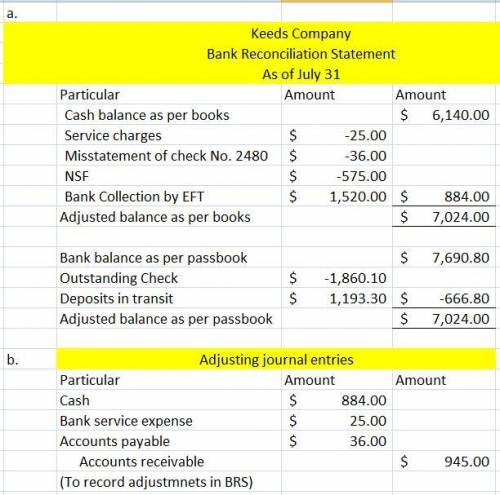
On July 31, 2017, Keeds Company had a cash balance per books of $6,140.00. The statement from Dakota State Bank on that date showed a balance of $7,690.80. A comparison of the bank statement with the Cash account revealed the following facts.
1. The bank service charge for July was $25.00.
2. The bank collected $1,520.00 for Keeds Company through electronic funds transfer.
3. The July 31 receipts of $1,193.30 were not included in the bank deposits for July. These receipts were deposited by the company in a night deposit vault on July 31.
4. Company check No. 2480 issued to L. Taylor, a creditor, for $384.00 that cleared the bank in July was incorrectly entered in the cash payments journal on July 10 for $348.00.
5. Checks outstanding on July 31 totaled $1,860.10.
6. On July 31, the bank statement showed an NSF charge of $575.00 for a check received by the company from W. Krueger, a customer, on account.
Required:
a. Prepare the bank reconciliation as of July 31.
b. Prepare the necessary adjusting entries at July 31.

Answers: 2


Another question on Business

Business, 22.06.2019 02:30
The dollar value generated over decades of customer loyalty to your company is known as brand equity. viability. sustainability. luck.
Answers: 1

Business, 22.06.2019 10:20
The different concepts in the architecture operating model are aligned with how the business chooses to integrate and standardize with an enterprise solution. in the the technology solution shares data across the enterprise.
Answers: 3

Business, 22.06.2019 11:40
Zachary company produces commercial gardening equipment. since production is highly automated, the company allocates its overhead costs to product lines using activity-based costing. the costs and cost drivers associated with the four overhead activity cost pools follow: activities unit level batch level product level facility level cost $ 64,800 $ 27,730 $ 15,000 $ 154,000 cost driver 2,400 labor hrs. 47 setups percentage of use 11,000 units production of 780 sets of cutting shears, one of the company’s 20 products, took 240 labor hours and 7 setups and consumed 15 percent of the product-sustaining activities. required: (a) had the company used labor hours as a company wide allocation base, how much overhead would it have allocated to the cutting shears? (b) how much overhead is allocated to the cutting shears using activity-based costing? (c) compute the overhead cost per unit for cutting shears first using activity-based costing and then using direct labor hours for allocation if 780 units are produced. if direct product costs are $150 and the product is priced at 30 percent above cost for what price would the product sell under each allocation system? (d) assuming that activity-based costing provides a more accurate estimate of cost, indicate whether the cutting shears would be over- or underpriced if direct labor hours are used as an allocation base. explain how over-or undercosting can affect vaulker's profitability. (e) comment on the validity of using the allocated facility-level cost in the pricing decision. should other costs be considered in a cost- plus pricing decision? if so, which ones? what costs would you include if you were trying to decide whether to accept a special order?
Answers: 1

Business, 22.06.2019 12:20
In terms of precent, beer has more alcohol than whiskey true or false
Answers: 1
You know the right answer?
On July 31, 2017, Keeds Company had a cash balance per books of $6,140.00. The statement from Dakota...
Questions


Chemistry, 09.07.2019 14:00

Biology, 09.07.2019 14:00




Mathematics, 09.07.2019 14:00

Social Studies, 09.07.2019 14:00

Mathematics, 09.07.2019 14:00



Mathematics, 09.07.2019 14:00

Mathematics, 09.07.2019 14:00





Mathematics, 09.07.2019 14:00

History, 09.07.2019 14:00

English, 09.07.2019 14:00




